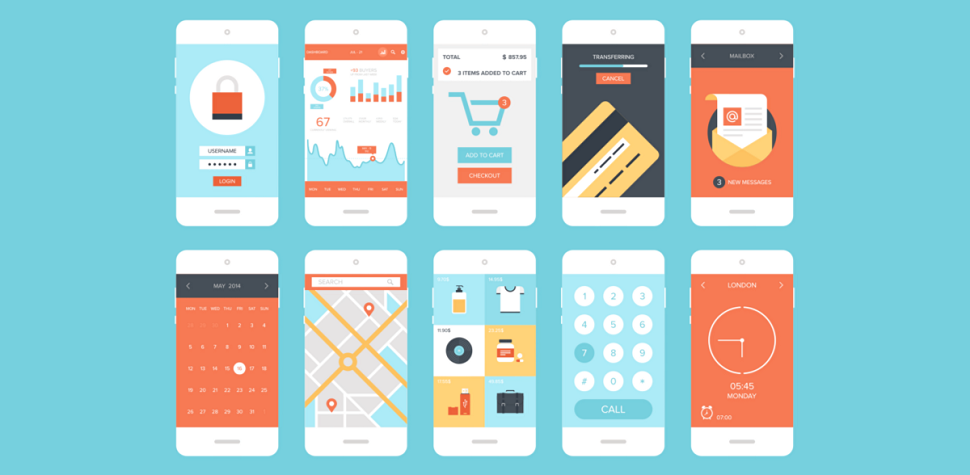M-commerce, IoT and Beacon. What to expect in 2020?
If it comes to shopping, ordering your favorite meal, saving money, calling a taxi or any other daily activity on the Internet, what device will you immediately think about to complete all these steps? About your smartphone, right! And so will do each of us. The cellular device has become a real friend for us and now greatly simplifies the solution of everyday tasks, thereby changing our attitude to information. It will not be a mistake to state that mobile technologies are developing at the speed of light and that applications have become an integral part of the digital ecosystem. Applications are developed and present in every area. And now to keep abreast of the latest trends in the development of mobile applications has become more a necessity, and not just an option.
Let’s look at 12 major trends in the mobile app market.
Fast mobile development
Companies are experiencing a difficult period due to the growing demand for mobile applications. Given progressive demands, enterprises compete to launch their products and services faster than anyone else. The main goal for mobile application developers will be to reduce the development life cycle and the time difference between the formation of the idea and the launch of the application. You can get acquainted with the advanced high-speed tools for application development and frameworks that currently exist on the market. Many companies are preparing to present solutions that can satisfy the consumer’s requirement for a quick launch of their application, and here you can give an example of Multicore JIT, Gesture Search, SwipePad, etc. Such solutions for mobile development were created on the basis of the idea of providing appropriate value for customers at each stage of development using key components, including quick launch and fast access to the market.
Influenced by cloud technology
Thriving cloud technologies are expected to play an important role in the application development revolution. Recently, there has been a significant shift in the use of mobile devices, and this leads to the fact that application developers pay more attention to the ability to integrate and synchronize applications developed for various devices. A cloud-based approach will help developers create functionality that can be easily used on various mobile devices with similar data and features.
There are currently several companies operating on cloud-based application development platforms. Application developers use a set of tools for building applications, continuous integration, testing and placing their applications in stores. This contributes to the fastest development process, and it is not necessary to have in-depth technical knowledge.
Security in applications
Recently, several reports have been published that indicate user problems with hackers. According to Gartner’s prediction, 75% of mobile applications will not be able to pass even basic security tests. Hackers will continue to exploit security flaws in mobile applications to gain sensitive and confidential information. Security is still a big problem in mobile applications. Today it is extremely important that developers take security issues such as insecure data storage, unwanted data leakage, open cryptography, etc.
Location-based services and Beacon Internet (Wi-Fi) technology
Beacon technologies (Beam) blur the line between online and offline, whether in the retail sector or in advertising. This technology is already used in iOS applications and is expected to be applied in Android systems in the near future. Almost every industry – retail, hospitality, tourism, education, healthcare, entertainment, travel, business, real estate, advertising, etc. – benefits from such online services. We can better understand this trend by the example of Beacon technologies that are used in large structures. Quite often you can see beacons installed in large buildings with cartographic goals. Thus, in сase of an emergency, you can quickly find where the problem has occurred. You can get a list of places monitored through beacons, or temperature sensors to help identify hazardous areas in emergency situations such as fires.
Carrier Technologies
The merit of Apple Watch – carrier technologies has become the most discussed topic in the field of consumer electronics. Most wearable devices developed so far have focused on the subject of health and fitness. But from the beginning of 2015, it is expected that carrier technologies will be used at enterprises in order to increase their efficiency and productivity.
As an example, now there is a rise in the field of fashion and the textile industry, and this happened after a decision was made on the use of carrier technologies. Therefore, the development of applications for cross-devices that can work both on cellular devices and on media, including any third-party device, is now actively supported. This will undoubtedly create unlimited scope for new applications and break the limitations of traditional applications for fitness and health.
Mobile banking, payments and M-commerce
Recent studies have shown that 19% of commercial sales are via smartphones or tablets. Analysts say that this trend will continue, as more and more consumers begin to use the services of M-commerce. Transferring money or purchasing goods using a mobile phone is becoming as common as using a credit or debit card. This means that developers can create mobile applications that can process transactions without the use of cash or any physical cards.
Internet of Things (IoT)
Like cloud technology, the Internet of Things (IoT) is gaining immense popularity. Although this phenomenon is only beginning to attract serious attention, in the future this attention will grow together with innovations and implementations that will open up a new world of communication and information sources. Some of the key IoT trends are new devices, the development of new standards for multi-touch support and M2M automation, as well as issues related to security and privacy issues. These trends clearly define the boom around IoT, which will lead to an increase in the use of related products and an increase in the required ecosystem. Some companies still underestimate the impact of IoT on the market and business processes are strongly encouraged to follow these trends, as this may affect their business goals.
Thus, it is expected that IoT will be everywhere, and developers are encouraged to create flexible mobile programs that would cover new opportunities.
Interaction experience, application analytics and a large amount of data
User Experience is the technology of the future. As the use of tablets, smartphones and wearable devices grows every day, experience with applications will become more important than ever. At first glance, this seems complicated, especially when you need to remember all the ads and purchases built into the application. Data analysis will play an important role here, which will help application developers improve their experience. Thus, you should not separate the successful development of mobile applications from analytics or the use of large amounts of data. Modern business requires an instant understanding of real data that reflects customer behavior and provides information about the decision-making process. The relationship between large amounts of data and application analytics takes place, on the one hand, in effective business processes and, on the other hand, in improving the experience of interaction.
Enhanced enterprise applications
According to IDC forecasts, 35% of large enterprises will use development platforms to create and launch mobile applications. This will lead to an upsurge in enterprise application stores that contain internal application ratings, allowing companies to filter out unused applications, thereby saving a huge amount of costs. Many enterprise application stores integrate with public stores that are available to a wider audience. In this way, mobile application developers will have enormous opportunities in the rapidly growing mobile market.
Marketing, advertising and in-app purchases
According to a new study by Juniper Research, in-app advertising costs across all mobile devices will increase several-fold. Mobile ads are no longer limited to banners; various ad formats, such as images, text or video, are being integrated and used right now. Both directions, mobile ads in applications and purchases, will become the focal point for monetization and the ladder to success, as many application developers are already moving away from paid download models.
Also, marketing methods in mobile applications are constantly evolving. In previous years, marketers have focused on attracting maximum user attention (downloading applications) instead of their direct involvement. Now developers and marketers have begun to understand the importance of increased experience for regular users. A regular user is considered more active and loyal than users collected using several paid channels. As noted earlier, a good interaction experience can be created by constantly analyzing user behavior and, accordingly, improving the application. The presence of Wi-Fi services and Beacon technology allows marketers to create a completely new type of advertising based on accurate information about the location and context of the user.
HTML 5
HTML 5 and other similar development tools are gaining in popularity. And since this technology will be used more and more often, enterprises will begin to use “hybrids” as the main technology for mobile applications. Unlike developing native applications, mobile applications are built using hybrid frameworks such as Ionic, Mobile Angular UI, Intel XDK or Sencha Touch, which are supported by various platforms. An important role is also played by the fact that getting to a large user base is becoming much cheaper. For this reason, developers should take a closer look at hybrid technologies and perhaps even think about their focus on developing only native applications.
Mobile games
In recent years, in the field of mobile games there has been a gradual movement towards multi-player games. And therefore, the integration of social networks in games will be more important than before. In addition, mobile games will increasingly depend on cloud technology to synchronize between different devices playing the same game, or between different users participating in the same game.
Would you like to create your own mobile game or enterprise application? Сontact us right now!
Related Posts
Leave a Reply Cancel reply
Service
Categories
- DEVELOPMENT (104)
- DEVOPS (53)
- FRAMEWORKS (27)
- IT (25)
- QA (14)
- SECURITY (14)
- SOFTWARE (13)
- UI/UX (6)
- Uncategorized (8)





